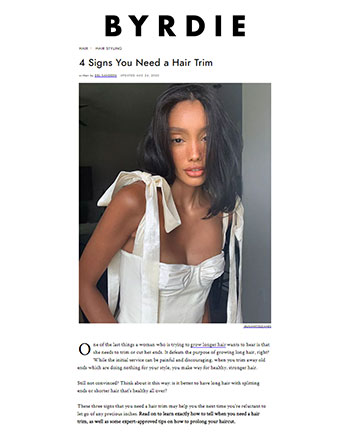Byrdie.com August 24, 2020
BYRDIE.COM
Hair
4 Signs You Need a Hair Trim
One of the last things a woman who is trying to grow longer hair wants to hear is that she needs to trim or cut her ends. It defeats the purpose of growing long hair, right? While the initial service can be painful and discouraging, when you trim away old ends which are doing nothing for your style, you make way for healthy, stronger hair.
Still not convinced? Think about it this way: is it better to have long hair with splitting ends or shorter hair that's healthy all over?
These three signs that you need a hair trim may help you the next time you're reluctant to let go of any precious inches. Read on to learn exactly how to tell when you need a hair trim, as well as some expert-approved tips on how to prolong your haircut.
MEET THE EXPERT
Amy Abramite is a creative director, salon educator, and stylist at Maxine Salon in Chicago.
Devin Toth is a hairstylist at Salon SCK in New York City.
Trim vs. Haircut: What’s the Difference?
As much as we may want one, there is no magic cure that will truly repair split ends. All you can do is prolong the inevitable, which is a trim or cut. While there are products on the market designed to temporarily hold your ends together in the meantime, the longer you wait to rid your hair of these unsightly ends, the higher the likelihood that split ends will turn into split hair strands that are even more damaged. Take a look at the ends of your hair; splits are easy to spot. Instead of a single hair strand that's intact all the way to the end, a split end looks just like that: two separate strands of hair at the bottom of the hair shaft, sticking away from one another, forming a V shape.
When it's time for a haircut, Devin Toth, hairstylist at New York City-based Salon SCK, says there is a visual cue that lets you know it's time to see your stylist. "The simple answer is that you only need a full-on haircut once your previous cut becomes grown out. In other words, when your previous cut loses its shape or becomes way too long." On the other hand, Toth says, "When you're asking your hairdresser for a trim, you're asking for a maintenance cut. You want to maintain your previous haircut's shape and length. That being said, hair grows about half an inch per month, so in order to maintain a hairstyle, the average client trims a full inch off every two months."
Signs You Need a Trim
"Split ends or dry ends are physical signs a trim is needed," says Amy Abramite, creative director and salon educator at Maxine Salon. "The cuticle will look damaged and feel rough to the touch, be difficult to comb through, and tangle easily." Another physical trait to look out for are ends appearing lighter in color than the rest of the hair. Abramite explains this is due to wear and tear from heat styling, environmental factors like sun exposure, or chemical services such as highlighting.
Regularly deep conditioning can help prevent extreme dryness, which leads to split ends, and eventually breakage.
Oftentimes, you can also tell your tresses are damaged because they:​
- Lack elasticity
- Are very porous
- Break off with ease
- Are crunchy and hard
If you've fallen victim to unhealthy practices that have left your hair damaged, there's usually little you can do except to start from scratch, with a trim or cut.
By the way, if you catch yourself unintentionally picking at your ends without realizing it, you probably need to have a professional cut those ends off, says Toth. "If your hair is easily getting tangled in your brush or fingers, then your ends are probably a little split and need a trim."
How Long Can You Go Between Trims?
Your hair may be perfectly healthy, but you've noticed that your style isn't as fresh as it used to be. You experience a lot of flyaway strands or you have to put more time in to get your 'do just right. This is another sign it may be time for a trim. The longer your hair grows, the more it gets pulled down due to its own weight. While this is good news for anyone who wants her hair to hang gracefully, it's not so good if you like gravity-defying styles that feature details such as flipped bangs and choppy layers. Make regular trim appointments with your stylist so that your 'do is always on point.
"Generally speaking, a trim is removing the ends to keep the hair in healthy condition," says Abramite. "This time frame can vary from person to person, depending on their beauty routine. If someone is heavy-handed on heat styling with a curling iron, or receiving a high lift color service, split ends can happen as quickly as four weeks. For others who naturally air-dry their hair and refrain from damaging beauty habits, 12 weeks is acceptable for a trim. The key is to monitor the ends before additional damage affects the cuticle any further."
How to Prolong Your Haircut
Rather than getting a trim every six to eight weeks for your hair's sake, you can prolong your most recent cut with some simple steps. Using the right products for your hair type are a given, and this includes your shampoo and conditioner. As hairstylist Tina Dizon tells us, avoiding tight hairstyles is a clear way to avoid breakage and prolong a trim. “The tighter the style, the more likely you’ll pull or break the hair from the root.” The same goes for when your hair is wet—do not pick it up.

